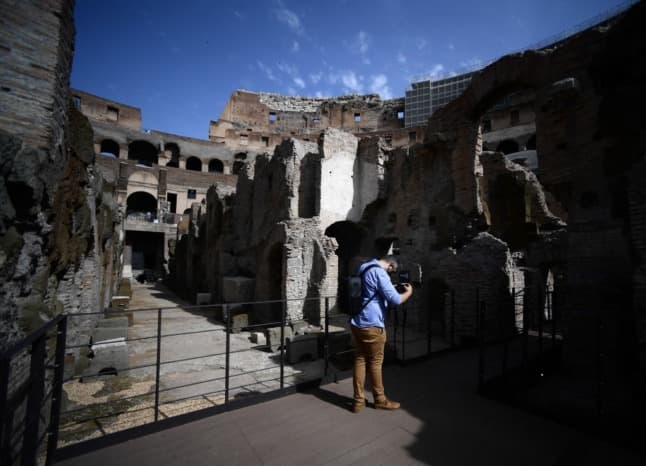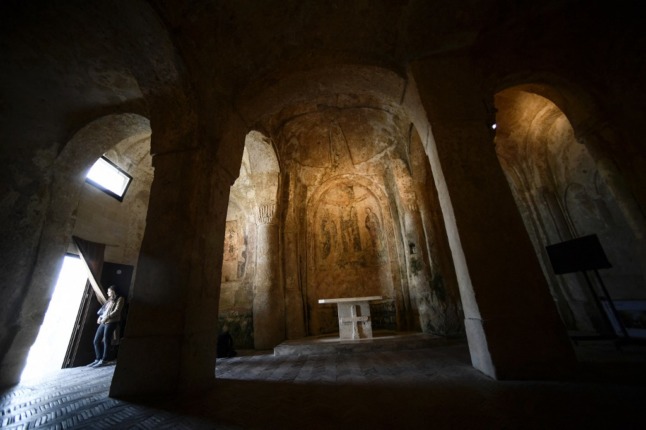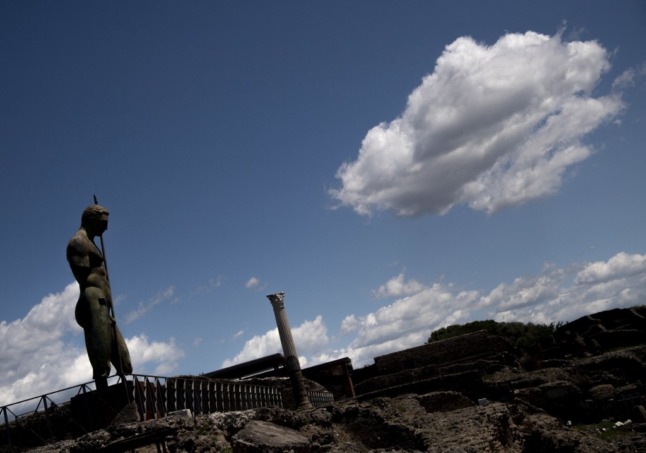OPINION: Why Italy urgently needs to hike entry prices to monuments and make people pay to visit churches

It’s time for Italy to stop undervaluing its precious artistic heritage sites before they’re lost to neglect and underfunding, writes Silvia Marchetti.
In Italy even the most remote villages have a handful of churches and smaller chapels. Chiming bells are a regular holiday soundtrack for tourists exploring the country. Most churches date back centuries and are treasure troves of art masterpieces.
But what makes these sites even more alluring is they’re totally free to visit.
Italy boasts amazing basilicas and shrines without entrance fees - bar a few exceptions. A total of roughly 100,000 churches dot the boot, nearly 900 of them belonging to the Italian state, others to local authorities, regions, confraternities and parishes.
READ MORE: Six breathtaking Roman ruins in Italy that you've probably never heard of
Catholics argue that nobody should ever pay for a prayer and God’s house must never be shut in order to welcome believers at all times, but then it often happens that priceless masterpieces are vandalized by visitors and sacred relics stolen. Or, in the worst case scenario, roofs collapse due to poor maintenance tied to a lack of resources.
If a church features unique masterpieces by Bernini and other great artists, and is in reality a ‘sacred museum’, shouldn’t people pay a fee to admire it, thus contributing to its upkeep? At least there would be extra revenue.
Italy’s religious architectural heritage is unique in the world and authorities should cash in on it.
Politicians and governments have long debated whether it is fair and moral to introduce tickets. After all, Italy is home to the Holy See that wants an ‘open church’ policy.
There’s a totally different reality in the UK and Ireland. Westminster Abbey tickets are roughly £20 per person, while St. Patrick's Cathedral in Dublin charges €8 even if one just wants to light a candle and say a prayer - which causes debate, but at least there's an income for the body in charge of maintenance.
One could argue that perhaps £20 is indeed a bit too expensive for a ticket, but €2 or €0 is ridiculous. If on one hand free entrance in Italian churches allows everyone to enjoy the mystical experience, on the other it undervalues it.

The Madonna delle Virtu cave church and its ancient frescoes in the southern Italian city of Matera. Photo: Filippo MONTEFORTE/AFP
Other southern European countries are doing a better job in making money from churches and top sites. Entrance to the mesmerizing Sagrada Familia basilica in Barcelona, designed by Antoni Gaudí, costs €27, while the Acropolis in Athens is €20.
Italy’s church ticket dilemma is strictly linked to the whole problem of having a ‘cheap’ culture - which comes at a high price.
Italy has the most UNESCO World Heritage listed sites in the world, yet doesn’t fully exploit these to raise revenue for the upkeep of its huge artistic heritage, a part of which is crumbling to the ground due to neglect and a lack of public resources.
READ ALSO: ‘More local, more authentic’: How can Italy move toward responsible tourism in future?
Tickets to the country’s archaeological sites, museums, Renaissance palazzos and medieval fortresses are way too cheap when compared to the rest of Europe and to the world.
Think about it: just €16 to visit three sites (The Colosseum, Roman Forum and Palatine Hill); €2 to admire the stunning frescoed rock crypts in the ancient southern city of Matera. If you’re over-65 or under-18, in most cases entrance is free or reduced. Reporters never pay.
The Colosseum is unique; people come from all over the world just to circle the fighting pit where gladiators fought against lions. If you close your eyes, you can almost hear the echo of the bloodthirsty crowds cheering for death. The ticket price should be raised to reflect the ‘experience’ the site offers.
Same goes for Matera: the cave-dwellings date back to prehistoric times. In the middle ages fleeing Byzantine monks took refuge in them and depicted sacred images on the cold, damp grotto walls. Entire families, with their animals, later lived inside these incredible places for centuries, up until the 1960’s. How can all this history and human life be valued at just €2?
READ ALSO: Matera, Italy's city of caves, contrasts, and culture
But there are also hundreds of other lesser-known, yet just as beautiful, artistic spots which can be visited without spending a single euro.
Tiny off-the-radar villages in Tuscany feature artworks by Renaissance masters, and there are hills surrounding Rome with medieval chapels and healing fountains cited by Dante in his Divine Comedy that have fallen into oblivion.

The archeological site of Pompeii has undergone a major restoration project funded by the European Commission and Italian authorities. Photo by Tiziana FABI/AFP
Spooky ghost towns particularly appeal to foreigners, yet we prefer to leave them to rot rather than cash in with ticket fees which could be used to bring these sleeping beauties back from the grave.
I was shocked when I recently discovered the archaeological site of the ancient Roman town of Norba in the Lazio region. It’s a small Pompeii, but in better shape than the real one: huge stone arched entrances, intact brick houses and breathtaking temples overlooking a green valley.
There was no ticket booth, I walked in and even used the toilet - for free. So I asked: what can I do to help? A boy sitting on a chair humbly said I could leave a tip, if I wanted, as all the maintenance work was carried-out by volunteers.
An Italian politician once said that “culture does not feed you”, meaning the arts and history are not a profitable business able to boost GDP. Truth is, without the needed investments and with low entrance fees to monuments, Italy could starve.
In the long run, having ‘cheap’ access to art can turn out to be counterproductive.
Comments (2)
See Also
In Italy even the most remote villages have a handful of churches and smaller chapels. Chiming bells are a regular holiday soundtrack for tourists exploring the country. Most churches date back centuries and are treasure troves of art masterpieces.
But what makes these sites even more alluring is they’re totally free to visit.
Italy boasts amazing basilicas and shrines without entrance fees - bar a few exceptions. A total of roughly 100,000 churches dot the boot, nearly 900 of them belonging to the Italian state, others to local authorities, regions, confraternities and parishes.
READ MORE: Six breathtaking Roman ruins in Italy that you've probably never heard of
Catholics argue that nobody should ever pay for a prayer and God’s house must never be shut in order to welcome believers at all times, but then it often happens that priceless masterpieces are vandalized by visitors and sacred relics stolen. Or, in the worst case scenario, roofs collapse due to poor maintenance tied to a lack of resources.
If a church features unique masterpieces by Bernini and other great artists, and is in reality a ‘sacred museum’, shouldn’t people pay a fee to admire it, thus contributing to its upkeep? At least there would be extra revenue.
Italy’s religious architectural heritage is unique in the world and authorities should cash in on it.
Politicians and governments have long debated whether it is fair and moral to introduce tickets. After all, Italy is home to the Holy See that wants an ‘open church’ policy.
There’s a totally different reality in the UK and Ireland. Westminster Abbey tickets are roughly £20 per person, while St. Patrick's Cathedral in Dublin charges €8 even if one just wants to light a candle and say a prayer - which causes debate, but at least there's an income for the body in charge of maintenance.
One could argue that perhaps £20 is indeed a bit too expensive for a ticket, but €2 or €0 is ridiculous. If on one hand free entrance in Italian churches allows everyone to enjoy the mystical experience, on the other it undervalues it.

Other southern European countries are doing a better job in making money from churches and top sites. Entrance to the mesmerizing Sagrada Familia basilica in Barcelona, designed by Antoni Gaudí, costs €27, while the Acropolis in Athens is €20.
Italy’s church ticket dilemma is strictly linked to the whole problem of having a ‘cheap’ culture - which comes at a high price.
Italy has the most UNESCO World Heritage listed sites in the world, yet doesn’t fully exploit these to raise revenue for the upkeep of its huge artistic heritage, a part of which is crumbling to the ground due to neglect and a lack of public resources.
READ ALSO: ‘More local, more authentic’: How can Italy move toward responsible tourism in future?
Tickets to the country’s archaeological sites, museums, Renaissance palazzos and medieval fortresses are way too cheap when compared to the rest of Europe and to the world.
Think about it: just €16 to visit three sites (The Colosseum, Roman Forum and Palatine Hill); €2 to admire the stunning frescoed rock crypts in the ancient southern city of Matera. If you’re over-65 or under-18, in most cases entrance is free or reduced. Reporters never pay.
The Colosseum is unique; people come from all over the world just to circle the fighting pit where gladiators fought against lions. If you close your eyes, you can almost hear the echo of the bloodthirsty crowds cheering for death. The ticket price should be raised to reflect the ‘experience’ the site offers.
Same goes for Matera: the cave-dwellings date back to prehistoric times. In the middle ages fleeing Byzantine monks took refuge in them and depicted sacred images on the cold, damp grotto walls. Entire families, with their animals, later lived inside these incredible places for centuries, up until the 1960’s. How can all this history and human life be valued at just €2?
READ ALSO: Matera, Italy's city of caves, contrasts, and culture
But there are also hundreds of other lesser-known, yet just as beautiful, artistic spots which can be visited without spending a single euro.
Tiny off-the-radar villages in Tuscany feature artworks by Renaissance masters, and there are hills surrounding Rome with medieval chapels and healing fountains cited by Dante in his Divine Comedy that have fallen into oblivion.

Spooky ghost towns particularly appeal to foreigners, yet we prefer to leave them to rot rather than cash in with ticket fees which could be used to bring these sleeping beauties back from the grave.
I was shocked when I recently discovered the archaeological site of the ancient Roman town of Norba in the Lazio region. It’s a small Pompeii, but in better shape than the real one: huge stone arched entrances, intact brick houses and breathtaking temples overlooking a green valley.
There was no ticket booth, I walked in and even used the toilet - for free. So I asked: what can I do to help? A boy sitting on a chair humbly said I could leave a tip, if I wanted, as all the maintenance work was carried-out by volunteers.
An Italian politician once said that “culture does not feed you”, meaning the arts and history are not a profitable business able to boost GDP. Truth is, without the needed investments and with low entrance fees to monuments, Italy could starve.
In the long run, having ‘cheap’ access to art can turn out to be counterproductive.
Join the conversation in our comments section below. Share your own views and experience and if you have a question or suggestion for our journalists then email us at [email protected].
Please keep comments civil, constructive and on topic – and make sure to read our terms of use before getting involved.
Please log in here to leave a comment.